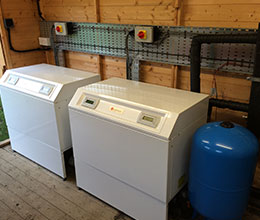Renewable Heat Incentive – don’t let surplus energy go to waste
Kensa Heat Pumps advise farmers on how to maximise onsite electricity use and reduce bought-in electricity in order to make use of the Renewable Heat Incentive.
The government’s Smart Export Guarantee (SEG) introduced in early 2020 to replace the export feed-in tariff (FIT) may be causing farmers to hesitate about investing in solar photovoltaic panels (PV) up to 5MW.
The SEG lacks a minimum price for exported electricity, requiring only that payments are greater than zero pence at all times of export. It is predicted that this will create a marketplace for energy firms to compete to offer rural businesses the ‘best price’ for the unused electricity they export.
 This places the onus on individual companies to set payment and contract terms.
This places the onus on individual companies to set payment and contract terms.
Kensa Heat Pumps, leading UK supplier and manufacturer of ground source heat pumps is suggesting that a better financial and environmental solution for farmers would be to maximise onsite electricity use with ground source heat pumps.
Kensa says: “The demise of the Feed In Tariff (FiT) and the scheduled introduction of the Smart Export Guarantee (SEG) has understandably caused a hiatus in solar PV applications, but this shouldn’t mean lights out on the opportunity for farmers to profit from surplus electricity generation.”
“We are seeing more and more savvy business owners utilising the electricity generated from onsite solar PV, wind, or even hydro, to power ground source heat pumps. This results in a triple-win of low-cost heating and hot water; complemented by the lucrative tariffs available through the government’s Renewable Heat Incentive (RHI) scheme; and the opportunity to use this heat energy for new business interests.”
Ground source sows the seeds of new business opportunities
Ground source heat pumps are electrically powered devices that harness the natural heat energy freely available from ground or water sources and upgrade this to provide heating and hot water. The technology produces three times more energy than it uses, making it an extremely energy-efficient source of heating, with no combustion, point-of-use emissions or pollution.
By pairing a ground source heat pump with onsite electric generating technologies such as solar PV, wind, or hydro, many happy Kensa customers are experiencing a holistic and rewarding renewably sourced heating and electricity supply. Indeed, with a typical solar installation costing around £6,000, less than half what it did when the FiT started, then the costs start to balance out thanks to the energy savings accumulated from renewably powering the energy-efficient heat pump, coupled with the Renewable Heat Incentive (RHI) income for the heat generated by the heat pump.
This 100% sustainable and renewable heat can then be used to create other income-generating activities, such as commercial drying processes, producing fertiliser from animal waste or rock salt for crisps, or for keeping greenhouses at an ambient temperature. As these ground source systems are eligible for generous funding from the Non Domestic RHI, the equipment costs will in most cases be quickly recouped.
Kensa case study: East Shaftoe Farm
One arable farm in Northumberland replaced an old oil boiler with a cascaded ground source heat pump system to provide heating to a farmhouse and outbuildings at a much lower cost.
By integrating the ground source heat pump system with the wind turbine and solar panels already on site, 100% of the farm’s energy needs are now supplied by renewable technologies. The owners have also directed some of the heat energy into a hydroponics system, allowing them to effectively diversify their business.
- Log in to post comments

